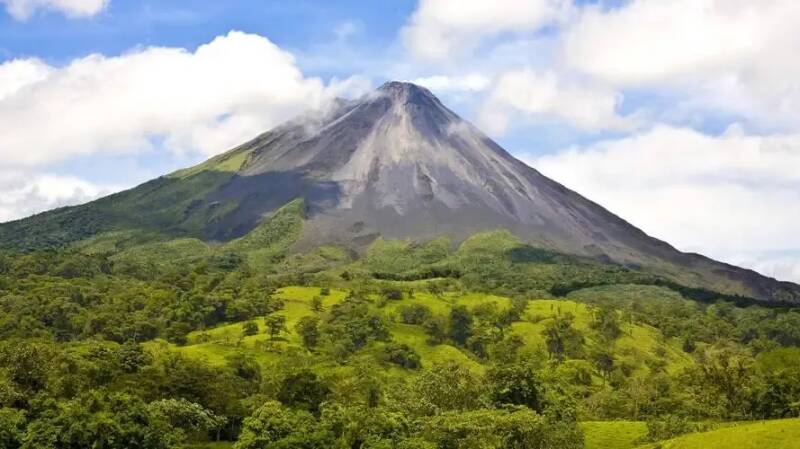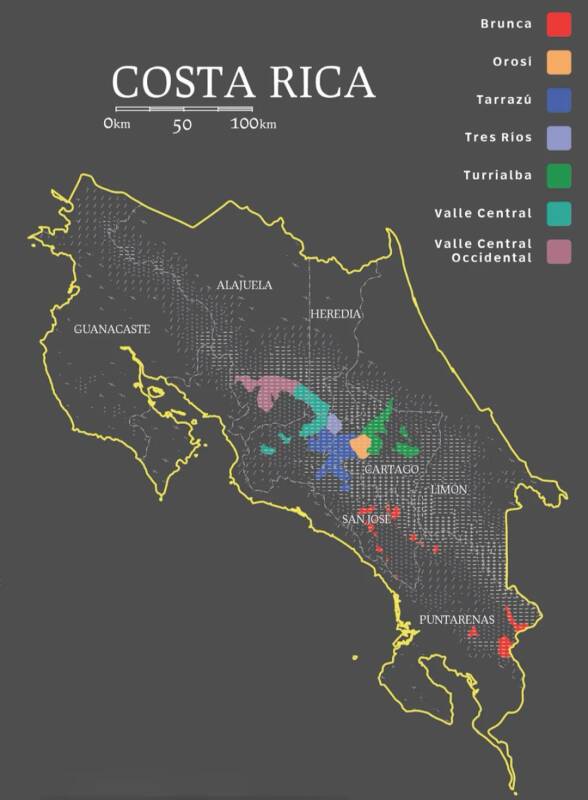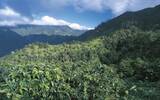Costa Rica| Introduction to the Blue Volcano Manor in the Western Valley Production Area
In the coffee growing belt, the American region happens to be in the coffee growing belt, and there are many famous coffee growing countries in the Americas, such as Panama, Honduras, Costa Rica, Guatemala and so on. Costa Rica is famous as the first country in Central America to grow coffee and bananas for commercial value.
Costa Rica Costa Rica
Costa Rica is located in the Central American Strait, bordering Nicaragua and Panama, the Caribbean Sea to the east and the Pacific Ocean to the west. A Costa Rican from Spanish, meaning "fertile coast".

Costa Rica is one of the countries with the richest biological species in the world, with nearly 5% of the world's species, nearly 30% of the country's land is a national park or nature reserve, the national forest coverage is 52.38%, and the climate is tropical and subtropical. And the country has more than 200 volcanoes, volcanic ash to the soil rich in minerals, coupled with mild and suitable temperature, abundant Rain Water, make the country's agriculture developed Is an important exporter of pineapple, banana and coffee in the world.
Coffee producing area
There are seven coffee producing areas in Costa Rica, namely: the Western Valley (Valley Central Occidental), the Central Valley (Valley Central), the Tarazu (Tarrazu), the Sanshui River (Tres Rios), Orosi (Orosi), Brunca (Bronka) and Turrialba (Duli Alba). Almost all of these areas are distributed in the central mountains.

Western valley (Valley Central Occidental): the western valley is located on the medium slope of the central mountains, planting 1000m~1200m above sea level, accounting for 25% of the country's output, with two volcanoes in the east and west, so there is fertile volcanic soil. Because it is close to the coastline and blown by the Pacific airstream, the annual average humidity is as high as 81%, and the rainfall is abundant, but the rainy season is dry and wet, and the sunshine is abundant in the dry season. There is also a well-known manor in this area, Blue Volcano Manor (Volcan Azul).
Blue Volcano Manor (Volcan Azul)
In the American region, many countries hold "Cup of Excellen" (COE), and Costa Rica is no exception. Costa Rica held the first COE competition every year after holding its first session in 2007, which will make the winning manor have enough reputation and considerable auction revenue.
Blue Volcano Manor is also actively involved in COE, appearing repeatedly on the list and winning the first place in Costa Rica's COE in 2013. The Blue Volcano Manor is located in the Alajuela Alajuela region of West Valley in the western valley of Costa Rica, the famous Poas Volc á n volcano in Costa Rica, on a hillside with an elevation of 1650-1700 meters.
At present, the manor is run by Alejo Castro, Alejo is the fifth generation of the Castro Kahle family, the manor has a long history, can be traced back to the middle and late 19th century. In the mid-9th century, when coffee farming started in the Americas, two entrepreneurs were also pioneers, Alejo Castro Jim é nez of Costa Rica (great-grandfather of the current owner Alejo) and Wilhelm Kahle, who shared a common ideal of "producing the best coffee in Costa Rica" and founded the Blue Volcano Manor together.
The owners of the estate pay great attention to the conservation of natural resources. they have been working to protect large tracts of the rainforest in Costa Rica since, and now they have acquired more than 1500 hectares of rainforest for coffee cultivation and environmental protection of the area.
At present, Blue Volcano Manor grows a wide variety of coffee, such as SL28, Kaddura Caturra, Obata Obata, Vera Saatchi Villa Sarchi, Rosa Geisha and San Ramon San Ramon. Alejo tries to plant new varieties every new season in order to minimize the negative impact of climate change on its harvest.
Important Notice :
前街咖啡 FrontStreet Coffee has moved to new addredd:
FrontStreet Coffee Address: 315,Donghua East Road,GuangZhou
Tel:020 38364473
- Prev

Can coffee beans be brewed casually if they are of good quality? Why should we pay attention to water injection when making coffee by hand? What is the difference between large and small water currents?
In order to enhance communication with guests and friends, most coffee shops make hand-brewed coffee in an open and on-site manner. This led to a certain amount of incomprehension when the barista was focused on injecting water. Because there is a saying circulating in the industry: As long as the beans are good, no matter how you brew, coffee
- Next

Kenya's coffee exports dropped by 4% and output dropped by 6.3% due to new government policies!
Recently, the U.S. Department of Agriculture released the current situation of the coffee industry in Kenya in African countries. The report stated that due to the decrease in coffee planting area and the impact of earlier heavy rains, Kenya's coffee production in the 2024/25 marketing year is expected to be 750,000 bags (60 kg/bag), compared with the previous marketing year
Related
- What effect does Italian American coffee with filter paper have? Will coffee taste better if it is put on filter paper at the bottom of the powder bowl?
- What is the color difference in coffee beans? What are the characteristics of honey processed coffee beans? Why are the anaerobically treated coffee beans uneven in color?
- How does novice Xiaobai quickly get started and make coffee? Newbies learn to make coffee by hand and share the specific steps and process process!
- Costa tea has a shelf life of 100 years?! Expert: Unable to verify
- It's a huge uproar! American milk addition was rejected by Manner employees?!
- Mocha pot coffee bean recommendations| How fine and how much powder should be used for grinding? What parameter ratios do I need to use to make milk with Mocha pot coffee?
- What are the characteristics of the world's top ten coffee beans treated with Costa Rica honey? How to make black honey kadura from Tarazhu Pilon Processing Plant taste good?
- How to make deep-roasted coffee? What grinding water temperature does authentic Jamaica Blue Mountain No. 1 coffee use to brew it well?
- Selected high-grade rose summer coffee flavor tasting guide Why Panama rose summer has the aroma of flowers and fruits
- What equipment does a novice Xiaobai need to buy to learn to make coffee? Filter cup electronic scale bean grinder manual flushing pot purchase guide

